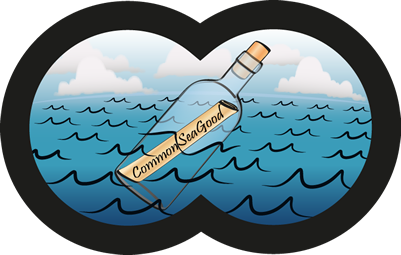Why should it be done
There are two good reasons to proceed
First, because we have to find new food resources :
The United Nations projections of human population growth are 2 billion people in the next 30 years, which means an increase of 25% of the current world population of 7.8 billion. Based on the assumption that these new members of our species will certainly want to eat something, our current food production must also be increased by at least 25% during the same time period. It is clearly evident that a 25% increase in agricultural production would require the adoption of broad open areas of currently unused land, as well as quality irrigation water in quantity. Whereas, in contrast, what we see around us is increasing urbanisation and desertification promoted by global warming. As these factors progress, available arable lands shrink dramatically. Our remaining forests and wilderness reserves are either highly coveted for agriculture or already acquired. Availability of fresh potable water, let alone irrigation water, is lessened by scarcity or pollution, and even most coastal seas are not longer free for additional exploitation.
So, where then is there still enough space and water? On the High Seas!
Second, because we need to keep the oceans resources (and ourselves) fit and healthy:
Oceans fish resources are currently overexploited. For several years now, despite the technical efforts of the fishing industry which has driven capture fisheries ever further and deeper, production by wild capture has stagnated. At the same time, overall production of seafood has increased thanks to aquaculture. This activity has become the fastest growing food production and is projected to overtake capture production in the foreseeable future.
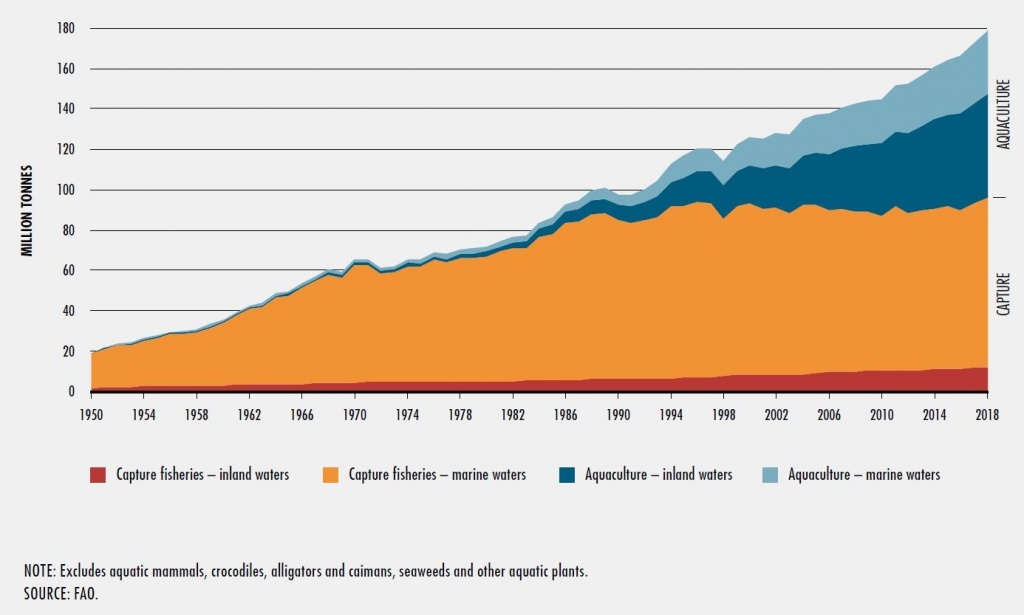
The inland farming of herbivorous fish (carps, tilapias) is still able to increase as long as appropriate locations can be found on land (thought such locations are becoming rare), but the marine farming of carnivorous fish (salmon, bass, cobia) or shrimp is following a course that is more difficult to justify, despite its current success. It appears that in the context of its global expansion, this food system bites its own tail, as increasing quantities of wild forage fish become necessary and these catches are rather declining. Consequently, the fish farming industry reduces the proportion of fishmeal and fish oil of their aquafeed and searches for substitudes. Current practices to feed farmed carnivorous marine fish with materials from terrestrial agricultural resources, instead of fishmeal and fish oil, may work technically, but make us actually lose all the benefits derived from these well balanced natural marine compounds which generate a healthy fish, and so, a healthy food for us.
Once caught, forage fish does not preserve well in its raw state. The whole fish has to be converted into fishmeal and fish oil (by cooking, screw-pressing and drying) if it is to be stored at room temperature for some time before use in aquafeed formulations. Fishmeal can be packed in bags. Fish oil for its part, is more fragile and must be hermetically sealed to avoid becoming rancid. More details with IFFO, the trade organisation of these reduction fisheries.
Apart from the good amino acid profile of their constituent proteins (concentrated in fishmeal after the forage fish is reduced) and their content of vitamins, minerals and trace elements, marine foods are healthy nutritional sources because they contain high levels of long chain omega-3 polyunsaturated fatty acids (LC-PUFA), which is concentrated in fish oil after the forage fish is reduced). DHA (docosahexaenoic acid) is responsible for many functions in animal cells, such as signaling, cell membrane fluidity, and structural maintenance through which they also influence the nervous system. EPA (eicosapentaenoic acid) is well known to lower blood pressure, slow the development of arterial plaque, reduce the chance of abnormal heart rhythm and the likelihood of heart attack and stroke.
Fishes, indeed all aquatic organisms, need large amounts of these omega-3 in their diet, as they are the fundamental component of all their cell membranes. These essential LC-PUFA cannot be synthesised by the fish themselves, but are nearly exclusively produced by phytoplankton, the first and basic marine trophic level of the food chain in which the phytoplankton is assimilated by zooplankton, which is assimilated by forage fish, and so on.
Without an appropriate amount of LC-PUFA, fishes are much more sensitive to stress, prone to diseases, and have a lesser capacity to reject harmfull parasites like sea lice. In most aquaculture farms, in order to grow fish properly despite those issues, feed has to be supplemented with antibiotics and the water treated with pesticides, which are both ultimately ingested by us. After some significant scandals, the fish farming industry has sought to improve its methods using vaccines instead of antibiotics and lumpfish (sea lice eating fish) or mechanical treatments, instead of pesticides. Other ways of ongoing improvements are to go further offshore, where the stronger currents can sweep the pollution away, or to filter the water in recirculating aquaculture systems (RAS) on land. But the main problem of the low level of LC-PUFA in aquafeed remains. With a long chain omega-3 rich diet, farmed fishes would be much healthier for themselves of course, but also for us, who are supposed to eat them.
For our part, as with all terrestrial organisms, DHA is a primary structural component of membranes in nerves in the brain, cerebral cortex, skin and retina. Further, EPA is another important LC-PUFA which is essential for cardiovasculare health. Consequently, the benefit to the human heart, eyes and brain is important enough for us to need to obtain LC-PUFA in sufficient quantities from our nutrition for healthy growth and development. It thus becomes quite critical to us to preserve farmed fish as a good LC-PUFA omega-3 source, particularly since an updated meta-analysis has shown that the protective effect probably increases with dosage.
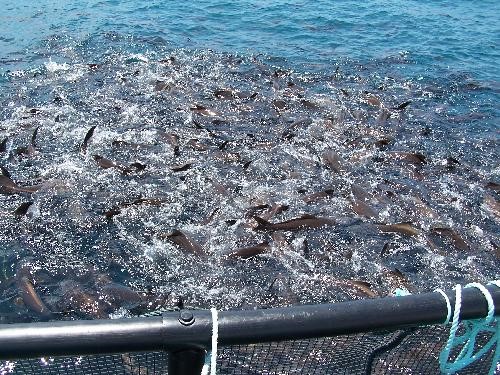
I am not alone in coming to this conclusion. Two kinds of attempts are in progress today to replace wild captured fish oil and supply more LC-PUFA omega-3 to the expanding aquaculture industry.
- Aerobic fermentation of heterotrophic microalgae discovered in muddy marine waters and fed with cane molasses in fermenters. AlgaPrime DHA is produced by Corbion. Veramatis, a joint venture of DSM and Evonik, produces a similar omega-3 algal oil using sugar derived from corn. Compared to forage fish reduction, it is a costlier process reserved for high-end markets. In any case, it contains mostly DHA, EPA not being in sufficient quantity for the desired balance of 2 EPA for 1 DHA.
- Genetically modified canola, with an added gene from a microalgae, has started in 2019 to be grown in Australia (Nuseed’s Aquaterra) and is forecast in 2020 in the USA (Cargill’s Latitude). This technology promises great things, like “one hectare of omega-3 canola provides the DHA yield from 10,000 kilograms of fish” and is certainly able to flood the market with its cheap alternative. But the very important EPA is almost missing. Moreover, I am not sure that the public acceptance for GM food will be secured one day. The promoters of this technology are certainly aware of this, because there is no mention of genetic engineering on their respective web sites.
- Insect meal is often presented as a third alternative, but the breeding of Black Soldier Fly (BSF), which is the most heavily industrialised, produces only proteins and saturated oils of value, but not the scarse LC-PUFA. The latter could eventually be produced by mealworms given an appropriate diet, but their rate of development in these conditions is probably too slow for this to be a profitable enterprise.
In any case, all these single compounds are only suitable for “modern” agri-food industries which are fond of cracking technologies down to their components. Thanks to mechanical (heat, freezing, pressure) or chemical (organic solvent, surfactant, acid or alkali) denaturation processes, each constituent of a natural food is separated into several low-cost nutrifunctional compounds, which in combination generate greater profits than the original (natural) food could have brought. Listed in catalogues, anyone can select different components to combine in any choosen food, with the required biochemical composition, aspect, flavor and palatability. This is the origin of junk-food, “la malbouffe” as it’s called in France. These ready to eat meals are strongly suspected to favor diabetes, cardiovascular failures and hormonal dysfunctions with their related chronic diseases.
The same technology applies to aquafeed pellet production. But we are not only what we eat, we are also what we feed. Biochemists and nutritionists should use their knowledge to enhance food production in accordance with nature’s laws rather than going deliberately against them. This plea comes from the heart. Let it be said, I believe in organic farming with some biodynamic precepts, agroforestry, multi-trophic aquaculture and the principles of permaculture to feed the world, rather than GMOs or industrialised farming and animal husbandry.
My ambition is to develop a natural and healthy animal protein source in the present desert of the High Seas. Enough to supply some long chain omega-3 rich feed to fish farms around the world (first to family pons and small scale farms in developing countries). This would enable fish farming to provide a healthy food for humans, while leaving more forage fish in the open sea to nourish penguins, seals, dolphins, whales, sharks, seabirds… and wild fish from the upper trophic levels to support artisan fisheries. I have tried to re-think the whole process of aquaculture feed management in a pragmatic way to the benefit of (nearly) all: fish farms, artisan fisheries and marine ecosystems. In any case, industrial fisheries are rapidly approaching the time by which they must be finished. The main thread of my reflection is based upon an implacable logic:
“The better our aquaculture, the less we fish, and let the oceans live”
How are we going to achieve it?
Let us take a look at the issues we may encounter
Local weather conditions are the first issue encountered when operating any infrastructure on the High Seas. So, let us first choose the only ocean which seems not to be prone to major cyclones, typhoons or hurricanes: the South Atlantic. It is also the ocean in which there are fewer fisheries and maritime traffic, so we should find an unoccupied and safe place there.

The lack of mineral nutrients for phytoplankton growth is the second issue on the high seas in general, and in the South Atlantic in particular. Except in some eastern areas, where constant wind from land cause upwelling, algae bloom and consequential important fish production, it is a real desert out there. Anyhow, we have to content ourselves with these desert areas, because the naturally rich zones along the African coast are already occupied and exploited. Further west, the nutrients present in the photic zone (above a 100 meters depth where light is available) are rapidly completely consumed by the photosynthetic activity of phytoplankton. In these conditions, the phytoplankton cannot multiply sufficiently to feed many zooplankton. That is why the high seas are biological deserts. No wind driven currents are strong enough here to mix the layers, and the minerals are not massively renewed from the deeper layers, where they stay present in quantity.
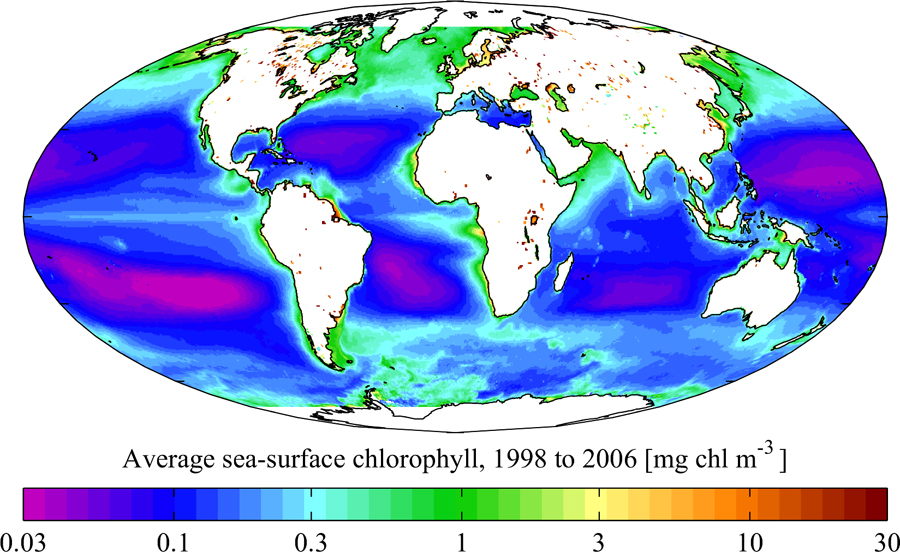
The challenge now is to bring together the existing nutrients from the depth and the light from above.
Logically, there are only two possibilities, take light down or bring nutrients up. Let us consider both.
Take light down:
Due to the aggressiveness of ultraviolet radiation from the sun in the upper sea layers, and also the constant adaptation of the controlled buoyancy of the phytoplankton, the optimal wavelength for marine algal photosynthetic activity is within the blue range of the spectrum, the one which has the highest water penetration coefficient.
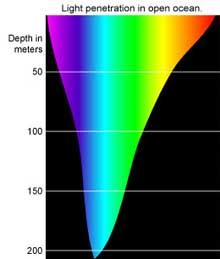 (Source: NOOA Ocean Explorer)
(Source: NOOA Ocean Explorer)
Luckily, thanks to today’s LED technology, we are able to produce exactly the blue light that is needed, with acceptable levels of energy demand.
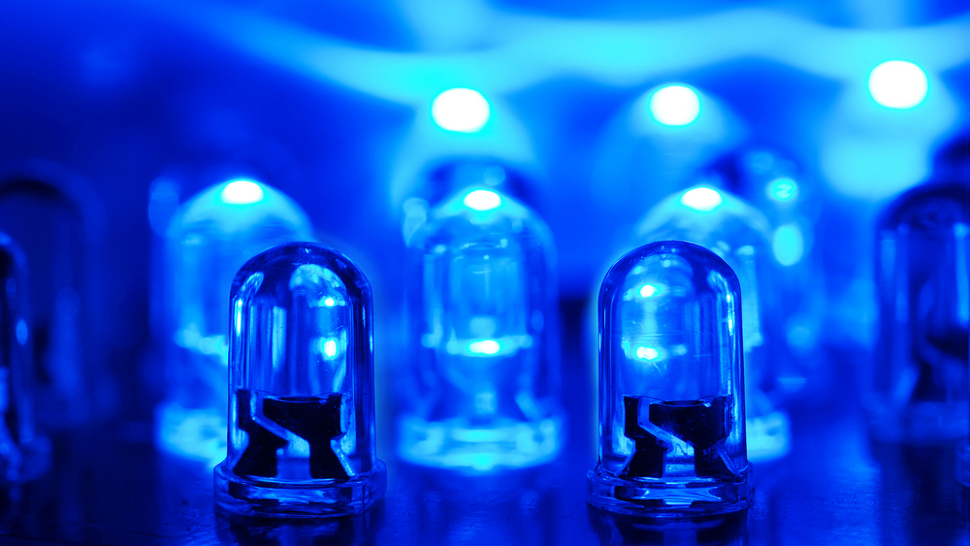
(Source: Gizmodo website)
Furthermore LEDs can be deployed easily in high pressure environments, because, unlike light bulbs, they are not hollow and cannot implode. But, even if we manage to illuminate properly a portion of the dark aphotic zone (below 100 meters depth) with arrays of blue LEDs, we still need to survey, handle and fix a production process in these depths. This is feasible, but too constraining.
Bring nutrients up:
Unfortunately, nutrients are diluted in great amounts of water, far too much to be pumped up with external (expensive !) energy to create an artificial upwelling. It would not be economically viable to spend so much energy. So can we bring up colossal amounts of nutrient-rich deep-sea water without energy? Yes we can! ![]()
Antarctic Intermediate Water (AAIW) is a nutrient rich, and low salinity water body, which characteristics are due, among other factors, to the mixture of seawater with mineral rich and fresh meltwater from the southern continental ice cap. These are the waters, where the Antarctic life explosion takes place every summer. AAIW then flows slowly northwards in every ocean. In the South Atlantic, it meets warmer and saltier sub-Antarctic water at the convergence zone, 50°-60°S. There, it sinks to a depth of approximately 1000 meters (3280 feet), gliding notherly over cold, salty and very dense bottom water.
A large part of it is flowing northeasterly to the South Atlantic Gyre, where it loses its characteristics by mixing. But a small part of it flows due north on the west side of the Atlantic, until it crosses over the Vitória-Trindade Chain, a volcanic hotspot chain east of Brazil. AAIW lays at this depth, and does not mix with the water layers above and below, even in this tropical region, where surface water becomes denser, due to evaporation causing increased saltiness. The sea stays stratified because the diffusion between the different water masses is low, no storms are strong enough in this region to mix the layers, and no constant wind from land forms an upwelling.
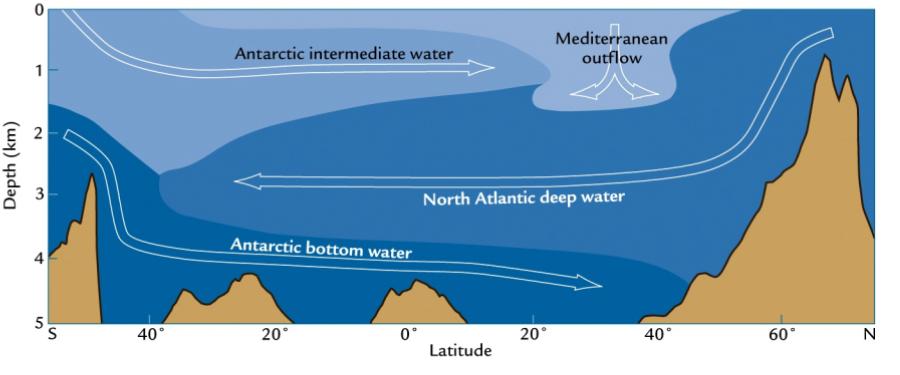
These conditions are ideal to set up a Perpetual Salt Fountain, an “oceanographic curiosity”, as it was first qualified by Henry Stommel in 1956. This can be made to work where you have a warm and salty water mass above a colder and fresher one. The technique is to insert a vertical duct between this two layers, and then pump it out until the pipe is filled with the deep water. You can then stop pumping. The upflow from the lower layer will last perpetually, without any other external energy expenditure. This is due to the fact that the heatenergy difference between the water masses is conducted through the pipe walls, but the salinity difference remains unchanged, both having an influence on the density. Thus, the water outside the pipe becomes heavier than inside and pushes the water upwards through the pipe. This property has been validated recently in open sea experiments in the Marina Trench area of the Philippines Sea by Shigenao Maruyama et al. from the Institute of Fluid Science, TOHOKU University. In our previous example, we have very salty and warm water above much fresher and colder water. The salinity having the largest influence on density, the salt fountain should be very strong here. This is our solution to bring nutrients up without energy spending.

Furthermore, AAIW, found today at 1000 meters depth in the tropical zone of South West Atlantic, was in contact with the atmosphere about 300 years ago, in other words, long before the Anthropocene, and the wide dissemination of anthropogenic pollutants. Even with the inevitable transfers between water layers, caused for example by the daily vertical migration of zooplankton, the concentration of anthropogenic pollutants in AAIW should remain insignificant. By contrasting the present state of seafood contamination with heavy metals and Persistent Organic Pollutants (POPs), these waters constitute a very attractive aquafeed and seafood production environment.
For several years now, the World Health Organisation has recommended us to eat fish for its healthy omega-3 content, but not more than twice a week, because of its pollutants content. Just before Christmas 2016, a leading French consumer association revealed also, that organic farmed salmon has higher contaminant levels than conventional farmed fish (both luckily well below WHO standards), due to a higher fishmeal inclusion in their feed. From my point of view, the (still relatively low) contamination of fishmeal is not due directly to wild forage fish, but either to the 30% sourcing of trimmings from higher trophic level fishes, in which pollutants accumulate most heavily, when packaged in the filleting factories. Anyway, it is time to take serious steps to reduce the currently observed contamination levels of farmed fish with heavy metals and POPs.
Another issue is to build an infrastructure with, at least, a 1000 meters deep anchorage, or with dynamic positioning. This is a quite outragous plan if you consider the scale of the engineering needed to reach the sea floor and the production levels we are aiming for. But the plan is made more realistic by seamounts, and more specifically guyots (also known as tablemounts) with a flat top, extinct volcanoes rising up from the seafloor, sometimes almost to the surface. Such a guyot is perfectly suited to support an infrastructure on its top and pipes along its slopes. In addition, due to Taylor columns effects (arising as a result of the Coriolis forces), seamounts have the particularity to let the isotherms rise and form a vortex that retains the surrounding waters. This phenomenon allows us to find AAIW at less deep level and, after being raised through the Perpetual Salt Fountain pipes, to keep it above the seamount for a sufficient time for exploitation.
A last issue is the provision of the required energy supply so far away from the continental shores. Leaving aside nuclear power which is a lethal activity for mankind, and fossil fuels which have no real future anymore, we must consider renewable power sources:
- Solar power: solar panels, deployed on a large area, are certainly too vulnerable in an open sea environment (at the moment).
- Wind power: wind turbines have already been anchored offshore, but may provide only an intermittent power supply.
- Wave power: Wave Energy Converter are fragile mechanical devices and are also unable to provide a regular supply.
- Ocean current power: marine turbines need a very strong current to be efficient and it is better to avoid that for our purposes.
- Power from osmosis: semipermeable membranes are expensive, cleaning chemicals are needed and the system is very complex to handle.
- Power from temperature gradients: Ocean Thermal Energy Conversion (OTEC) plants are also very sophisticated systems and need chemical refrigerants.
If none of these are acceptable candidates, what else is there? I think on Earth’s internal heat power. Yes, geothermal energy on the High Seas! ![]() Why not, being located just above an extinct volcano, rising up from the seafloor almost to the surface.
Why not, being located just above an extinct volcano, rising up from the seafloor almost to the surface.
Where could this take place ?
The Brazilian continental margin includes several volcanic islands and submerged volcanic seamounts. I have located a suitable guyot in the Vitória-Trindade Chain, east of Brazil, the Davis Bank. It rises from 4000 meters on the sea floor to less than 50 meters depth (160 feet), and has a very large flat top of around 90000 hectares (222000 acres). In the tropical southwest Atlantic, it is the best suitable seamount, which does not belong (yet) to a national Exclusive Economic Zone (EEZ).
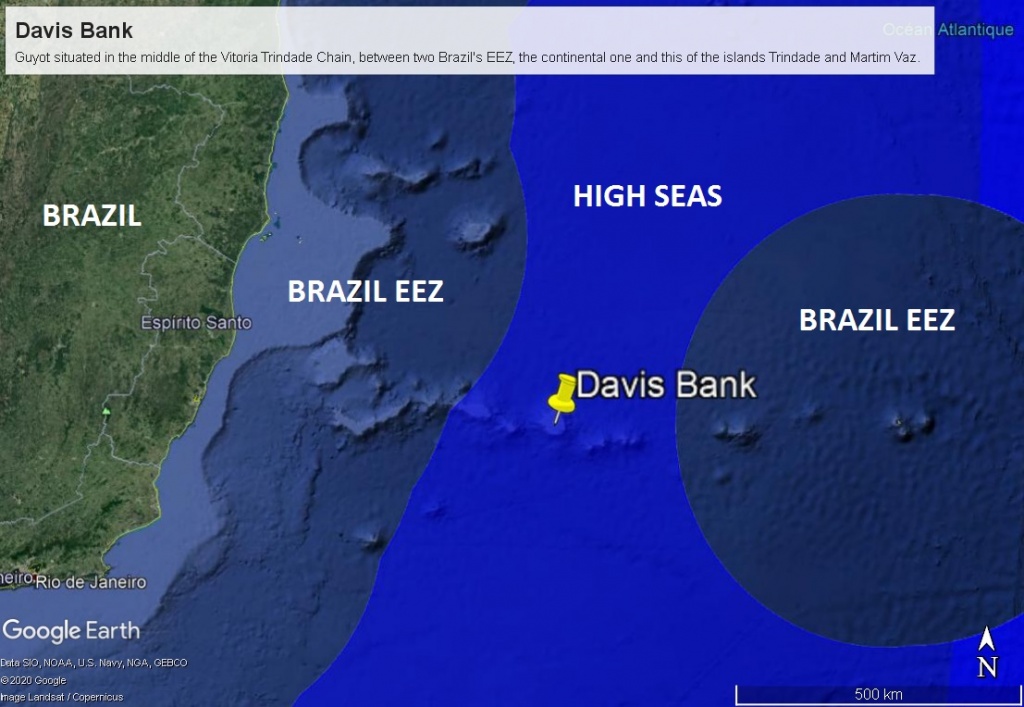 (Source: KML file of Marine Regions on Google Earth)
(Source: KML file of Marine Regions on Google Earth)

(Courtesy and source: KLM file of Marine GeoGarage with data of Centro de Hidrografia da Marinha do Brazil on Google Earth)
What shall we raise there ?
The core of all production in the sea is phytoplankton, which multiplies rapidly, subject to presence of mineral nutrients and light. From there on, a short trophic relationship with an organism, which has a good conversion efficiency, would be the most effective and healthiest way to produce anything.
Sessile filter feeders like mussels are good candidates, because they belong to the second marine trophic level, don’t spend any energy to swim and cannot escape. The very short trophic relationship between primary production of phytoplankton and production of mussels assimilating it, combined with the very pure AAIW quality, are the unquestionable guarantee of the lowest level of anthropogenic pollutants at the end of the production process.
Mussel aquaculture has been practiced for centuries, even millennia, because it is rather an easy culture. They multiply profusely, attach themselves on any surface or created device, and feed on any organic matter they find. Several techniques are used nowadays.
- Bouchot culture: pilings, known in French as bouchots, are planted at sea; ropes, on which the mussels grow, are tied in a spiral on the pilings; some mesh netting prevents the mussels from falling away. This method needs an extended tidal zone to be able to work on it at low tide.
- On-bottom culture is based on the principle of transferring mussel ‘seed’ (spat) from areas where they have settled naturally to areas where they can be placed in lower densities to increase growth rates, facilitate harvest, and control predation.
- Raft culture is a commonly used method throughout the world. Lines of rope mesh socks are seeded with young mussels and suspended vertically from a raft. The specific length of the socks depends on depth and food availability.
- Longline culture (rope culture) is the most recent development for mussel culture and is often used as an alternative to raft culture in areas that are more exposed to high wave energy. A long-line is suspended by a series of small anchored floats and ropes or socks of mussels are then suspended vertically from the line.
Using long lines is the most productive technique for mussel aquaculture, because it takes advantage of the volume in the water column, instead of a surface. However, this production method, intended for human consumption, is too expensive, and needs to be adapted to fit aquafeed production. Several sorting and cleaning stages essential for harvests intended as human food can for instance be abandoned, freeing a lot of time and money. The long lines themselves are too expensive in their present form, and also need to be re-designed.
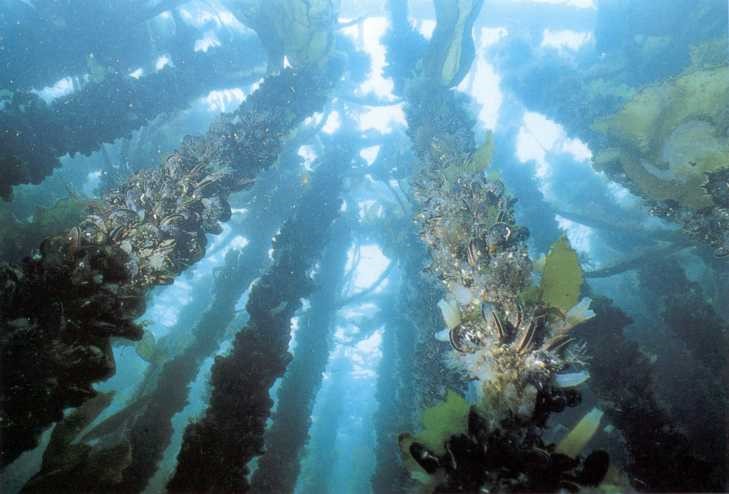
Despite the reservations just expressed, long lines mussel farming is by far the world’s most productive breeding method, currently yielding 150 to 300 tonnes, per hectare per year. To put these figures into perspective, beef production is only around 0,340 tonne per hectare per year, almost a thousand times less! With mussels on long lines, we can reasonably forecast (if the carrying capacity is given) a production between 3 to 6 million tonnes of mussel flesh (50 to 75% is shell) in a square of 90.000 ha, like the flat top of Davis Bank. This figure for the potential yield can also be compared to the 5.5 million tonnes of Peruvian anchovies caught in 2018, which is the world’s largest fishery dedicated to the production of fishmeal and fish oil. These were their highest landings since 2011 and unlikely to be heavily surpassed, due to government conservation policies that limit the Total Allowable Catches (TACs). Moreover, 2018 did not experience the famous El Niño event, which periodically occurs and results in a temporary collapse in yield of this reduction fishery.
However, as a consequence of the relative ease of culture, some aspects of the biology of mussels, such as their most efficient diet, have only been poorly documented. We know that mussels filter and ingest plankton and other organic particles from 5 to 15 microns. Diatoms, the main intake, provide DHA (good for our brain) and flagellates provide EPA (good for our heart), both important LC-PUFA omega 3. Control of mussels’ diet, neglected until now, is all important here, especially if it can be easely managed.
Each mussel filters nearly 100 liter water a day. Retaining all the particles present in the water, its food conversion factor can fluctuate, between 30 and 80%. That means mussels produce between 20 and 70% faeces (which pass through the digestive system), or pseudofaeces (materials which are immediately rejected). These sink and pollute the seabed below, because the organic content is not enough degraded by aerobic bacteria during sedimentation, especially when the sea floor is not very deep, which is the case in most coastal areas where mussels are farmed. When the faeces accumulate on the sea bottom, digestion depends on anaerobic bacteria which have a negative impact on ecosystem health. That’s why knowledge of the most efficient diet for mussels is so important. Especially if we are able to influence this food conversion factor and the nature of the metabolised substances, by using the appropriate phytoplankton mix to feed the mussels. In our plans, the most favourable phytoplankton species could be injected into the rising nutrient-rich AAIW passing through the salt fountain pipes, to let them multiply on their way up, thanks to strings of blue LEDs inside the pipes. In this way it should be possible to control the diet of the cultivated mussels, in order to minimize faecal output and maximize LC-PUFA omega-3 production.
Now we have the framework. But it will not work as described so far because of the environmental footprint of such a huge mussel farm. To avoid contamination, it still needs either to be distributed between several places, or at least trophically compartmentalized in some way, by cultivation of macroalgae for example. Anyhow, it needs also to be associated with other cultures to establish greater biodiversity among the species so that the mussel farm becomes a self-sufficient biotope. This approach is called Integrated Multi Trophic Aquaculture (IMTA) where the waste products of one species are recycled as feed for another.
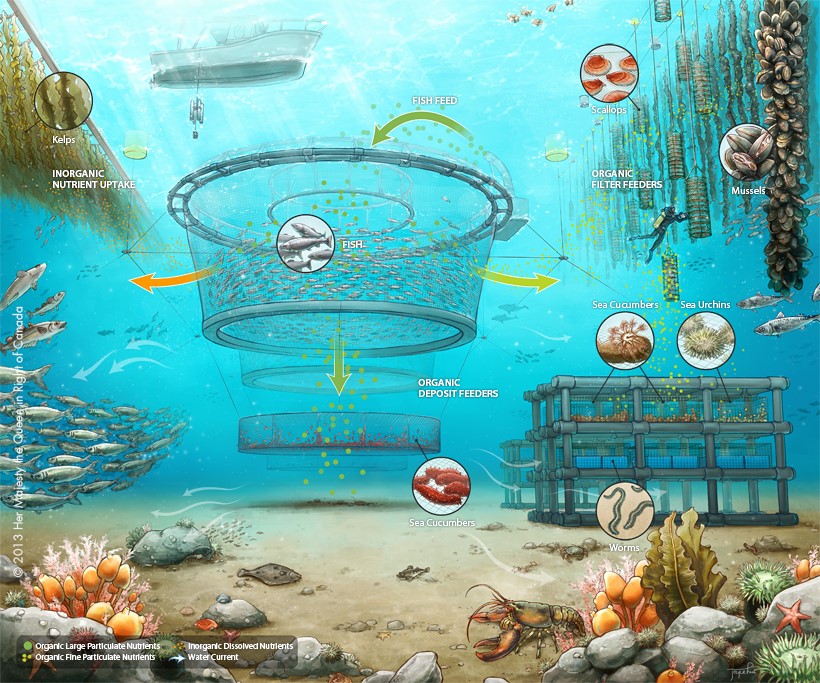
Mussel faeces cause pollution problems in most of today’s monoculture areas. To avoid this, the soluble faeces can be assimilated by kelp or another macroalgae, and the solid ones can be assimilated by scavengers on bottom like sea cucumbers. These will also strongly contribute to the project’s viability, because of their value for Asiatic people, who appreciate them a lot as food and medicine. You can read more about it on the website of the IMTA Research Laboratory.
However, despite IMTA technics, such a mussel farm will lead to a huge threat for the existing biodiversity of this rhodolith covered seamount, which counts several species of algae, corals, crustaceans, sponges, fishes, some of which are endemic. In short, Davis Bank is a rich reef biotope as shown in this video below entitled “Fish biodiversity of the Vitoria-Trindade Seamount Chain – Pinheiro et al 2015”.
Since this filming in 2005, carbonates mining to provide fertilizers for Brazilian sugar-cane plantations has occurred on seamount summit, together with mining trials of cobalt-rich crusts on slopes. Moreover, for several years now, fleets of fishing vessels from China, South Korea, Portugal and Spain commonly work there, as we can observe on Global Fishing Watch.


If this fleets use bottom trawls, the reef might already be in pretty bad shape. I don’t know how this paradise looks like today, but if it is still pristine despite these damaging attacks, we may perhaps choose a less space requiring marine organism than bivalve molluscs farms for our purpose.
Copepods are also good candidates. From 13 000 species of known copepods, 10 000 are marine and 5 000 of them are nonparasitic and free living zooplankter, like calanus. Populations of these 1-2 mm crustaceans are so large that they represent a considerable marine biomass and are, in nature, a crucial link between energy-producing phytoplankton and fish. Like mussels, they belong to the second marine trophic level. In spring, they aggregate together in huge swarms near the surface, until seawater becomes like a syrup that the baleen whales scoop in big mouthfuls.
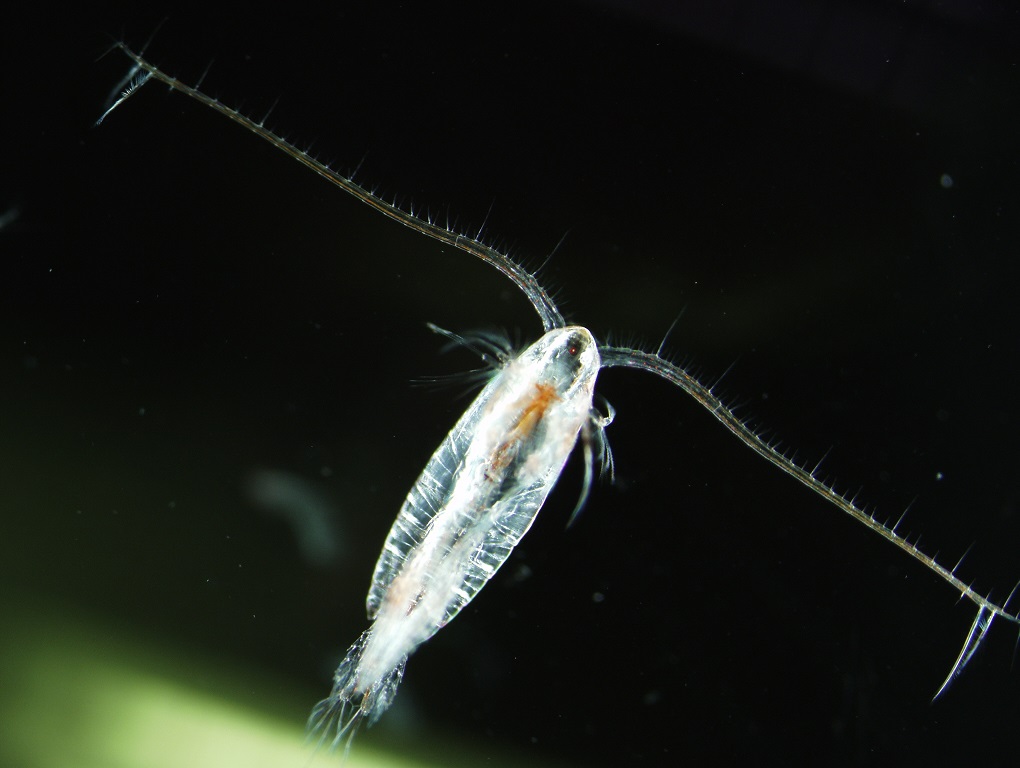
A single copepod can catch and consume a few hundred thousand phytoplankton cells per day, clearing about a million times their own body volume of water. They feed at the surface at night to avoid visual predators and eventual toxic emanations from phytoplankton. At daytime, they sink several hundred meters down to stay protected. In Polar Regions, they sink even to a thousand meters depth to hibernate during the cold season and live on their reserves,accumulated during the summer.
This is why their metabolism allows them to build up a very high protein and LC-PUFA content. To be able to sink, they change their oils into denser fats, wax esters. They also accumulate astaxanthin, a lipid soluble carotenoid, well known for its anti-oxidant properties, which enables them to hibernate with preserved stocks of nutriments. Astaxanthin is also the substance that gives the orange-red color to wild salmon flesh. Fish feed is currently supplemented with synthetic astaxanthin to avoid rancidness and give the right color to farmed salmon flesh.
With a view to breeding calanus spp. for fish feed, some very interesting properties can be highlighted:
- They are already natural wholesome fish feed, a not transformed whole feed for aquaculture.
- They aggregate together naturally and can thus be easily harvested.
- They have a very high protein and LC-PUFA content, naturally well balanced with all needed micronutrients.
- Bound as wax esters, the LC-PUFA are much better assimilated as those of fish oil and lead to very pronounced positive effects on important metabolic parameters.
- Thanks to their astaxanthin content which acts as a self-preservative, they may not need to be processed into meal and oil to be stored at room temperature.
My expectation is that we should be able to breed swarms of Calanus spp. inside the Perpetual Salt Fountain pipes, harvesting them on the top outflow to avoid threat to the environment.
All these conclusions of mine are written without reference to all the sources I have used, because I do not claim to have done a scientific work. The latter has finally been accomplished with the precious assistance of Dr. David Moore and has been published on January 1st, 2021 in the Mexican Journal of Biotechnology under the title Saving the Planet with Appropriate Biotechnology: 3. The High Seas Solution, as part of a complementary project aimed at rehabilitating the benefits brought by marine calcifiers in terms of climate change remediation, coastal conservation and food sufficiency.
Obviously, a great deal more research needs to be done but this logical frame of pragmatic ecology and oceanology suggest my project has a solid base to counteract the challenges of fish farming sustainability and preservation of the biological productivity of the open oceans.. We must start these efforts by installing a pilot station of perpetual salt fountain pipes on Davis Bank.
Follow me on My vision.
